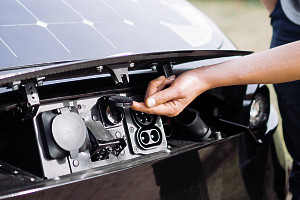This technology allows intelligent management of the electrical energy budget of an electric vehicle.
Munich, September 4, 2020 – The electric vehicle start-up from Munich, Sono Motors, has been granted a European patent for its bidirectional charging system known as biSono. The basis for this technology is a newly developed charger, which can be used to charge, store, and release electricity. To draw electricity, the car is connected directly to an external energy consumer, an example would be another electric vehicle. For the first time, the charging or discharging process can be controlled via a control unit, such as an app or the vehicle’s infotainment system. With the development of this technology, Sono Motors offers a more efficient solution for electric vehicles that draw all or part of their energy from integrated solar cells. If solar vehicles generate more power during the day than can be absorbed by the vehicle’s battery, biSono technology makes it possible to quickly and easily make unused solar power available to other devices or vehicles.
The innovative system will be used for the first time in the company’s own Solar Electric Vehicle (SEV) the Sion. In combination with viSono, the solar system integrated into the Sion’s vehicle body, other electronic devices and vehicles can be supplied with up to 11 kW of emission-free solar power completely autonomously. In addition to a CCS module for charging the vehicle, a standard household power outlet plug and a high-performance type 2 plug are integrated into the vehicle’s hood to draw power.
The user of the vehicle can then control the power withdrawal via a specially developed app or alternatively, via the vehicle’s infotainment system. In doing so, they can choose if and how much power is to be made available to external electrical consumers and how much power is to remain in the vehicle.
Laurin Hahn, Co-Founder and CEO of Sono Motors: “Patenting our bidirectional charging system is another important milestone on our way to becoming a mobility service provider. The technology allows us to enable intelligent power sharing, i.e. the sharing of stored energy via an app. The Sion can thus not only be charged via the power grid, but becomes part of the charging infrastructure itself.”

